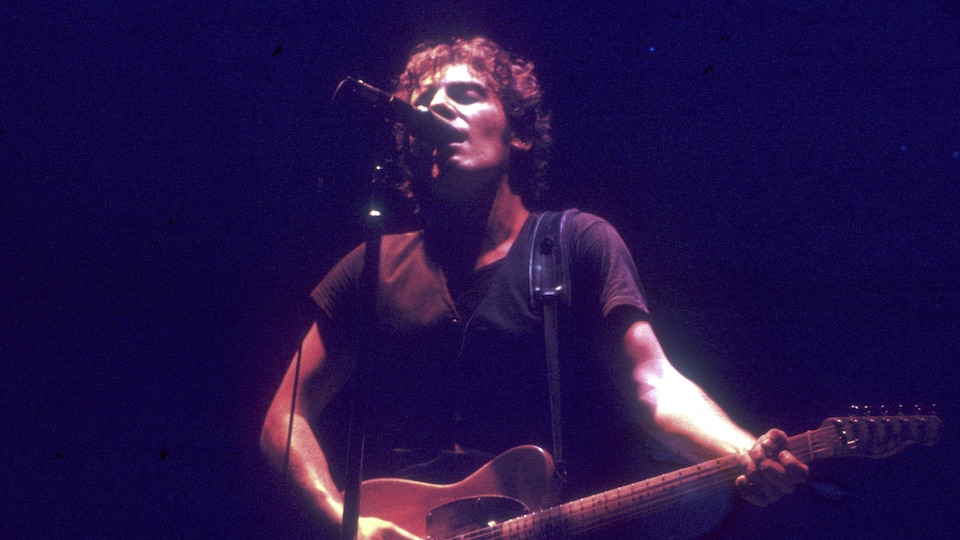Love him or hate him there is no denying that Bruce Springsteen is eternal. His music is woven into the fabric throughout rock n roll history and the American storybook. What marks Springsteen as such a treasure is his effective use of storytelling. His songs throughout his career portrayed candid stories that bred life, love, and emotion into the listener. Well into the autumn of his career, The Boss finally told the story listeners have been yearning to hear: his own.
Coming off the success of his autobiography Born to Run, Springsteen wanted to turn his life story into a live performance.
Throughout the years Springsteen’s concerts have become a thing of legend due to their high energy, interaction, and tenacity often extending over 3 hours into the night. But in order for this story to be told Springsteen needed to rebuild everything he had ever done by tearing it all down. To bring his vision to life he wanted to construct an intimate show in a small venue. Springsteen decided on Broadway “because it has the beautiful old theaters which seemed like the right setting for what I have in mind” he told the New York Times.
Related: “Reconsider Me: Bruce Springsteen’s ‘Working On A Dream'”
The task of telling one’s own life story in a two-hour window is an incredibly overwhelming concept. To do so The Boss constructed a formula that gave the program its identity. Springsteen carefully compiled a selection of songs from his catalog that he felt could chronologically embody his life’s journey. The show’s focus would not lay on his path to his success but the stories that defined him as a person. Springsteen prefaced each song with monologues that gave each song selection firsthand context and meaning. At Springsteen’s helm, the show would come together to make one of the hottest shows in the market.
Initially, Springsteen planned for an eight-week residency at the Walter Kerr Theater but due to overwhelming demand the show was extended multiple times and continued over 14 months totaling 236 shows. The show became such a hot item that ticket sales fell prey to a plague all too familiar with the 21st-century concert-goer: “bots” sweeping up tickets to resell in large quantities before audiences had a chance to buy them at face value. Resale prices ranged anywhere from one to six-thousand dollars. The show quickly garnered an elusive mystique about it as only those willing to pay a four-digit sum and travel to NYC would bear witness to what, according to The Guardian, was being hailed by concert goers as “the best thing I’ve ever seen”. To counter this, Springsteen had struck a deal with Netflix to document the performance and make viewable for the whole world to see. So on December 16th, 2018, Netflix released the special Springsteen on Broadway mere hours after the shows’ final performance.
As the program began The Walter Kerr Theater stage lay dimly illuminated by a handful of stage lights and an absence of a backdrop. The brick walls lay uncovered with electric chords hanging for all to see. The stage was occupied by nothing more than a piano, microphone stand, a handful of supply trunk cases, and a stool with a glass of water on it. The minimalist setting was a symbolic idea of what at its core Springsteen on Broadway truly was; exposed, naked, and transparent.
Underneath the spotlight stood Springsteen alone dressed in nothing more than a black t-shirt and jeans with acoustic guitar in hand. The Boss journeyed listeners through the memories in his life that shaped the American icon that the world has come to know with stripped-down versions of songs the world has to come to love. The voyage started fittingly in Springsteen’s home town of Freehold, New Jersey with his debut hit “Growing Up” and transitioned into “My Hometown” as he relayed anecdotal detail of the candid persistence of human spirit in rural America.
Related: “Bruce Springsteen: The Boss of Concerts”
He recounted his embattled relationships his parents (‘My Father’s House’/‘The Wish’), hometown (‘The Promised Land’) and his own youthful restlessness of yearning to break free into the unknown (‘Thunder Road’.) Poignant tributes were paid to The Big Man himself, Clarence Clemons (‘Tenth Avenue Freeze-Out’) and his wife Patti who joined him on stage for duets of ‘Tougher than the Rest’ and ‘Brilliant Disguise.’ Given today’s precarious political climate The Boss felt compelled to give his take on what he described as ‘the ‘continued fight for the soul of the country’ with “The Ghost of Tom Joad”, “The Rising”, and “Land of Hopes and Dreams.” To round out the end of the show, Springsteen played two of his biggest hits with conservative versions of “Dancing in the Dark” and “Born to Run”, inevitably coming full circle with the song that put him on the map.
The performance that helps bookend a career with nothing left to prove served as something greater than its initial purpose. Springsteen’s innate ability for storytelling and intricate detail was the secret ingredient that propelled Springsteen on Broadway to be of the most original and defining shows of the decade. In a day and age where listeners are apt to fall victim to anxiety induced by sensory overload, Springsteen on Broadway was the genuine experience that had us stop, let down our guard, and remind us what it means to be human; the magic trick Springsteen continues to champion all these years later.
-Michael Sarno
Photo Credit: CIRCA 1970: Photo of Bruce Springsteen Photo by Michael Ochs Archives/Getty Images)





0 comments on ““Springsteen on Broadway” Champions Human Connection”